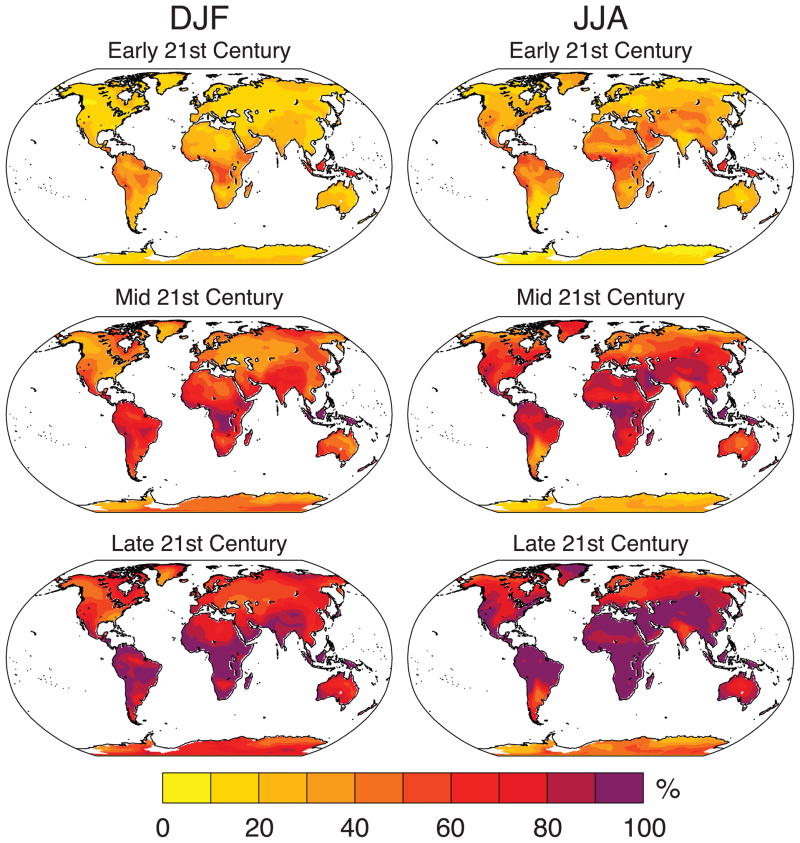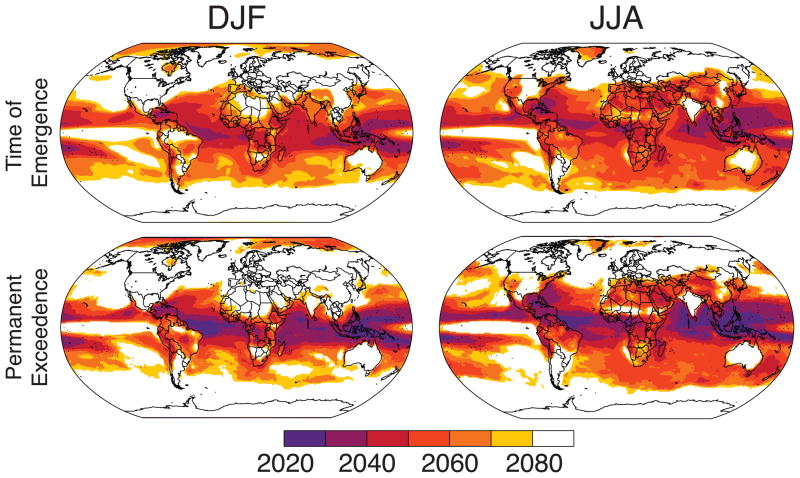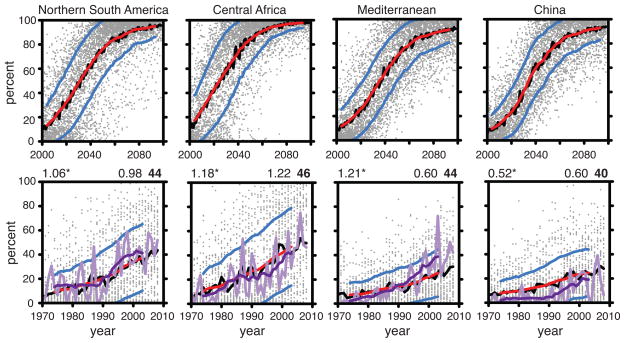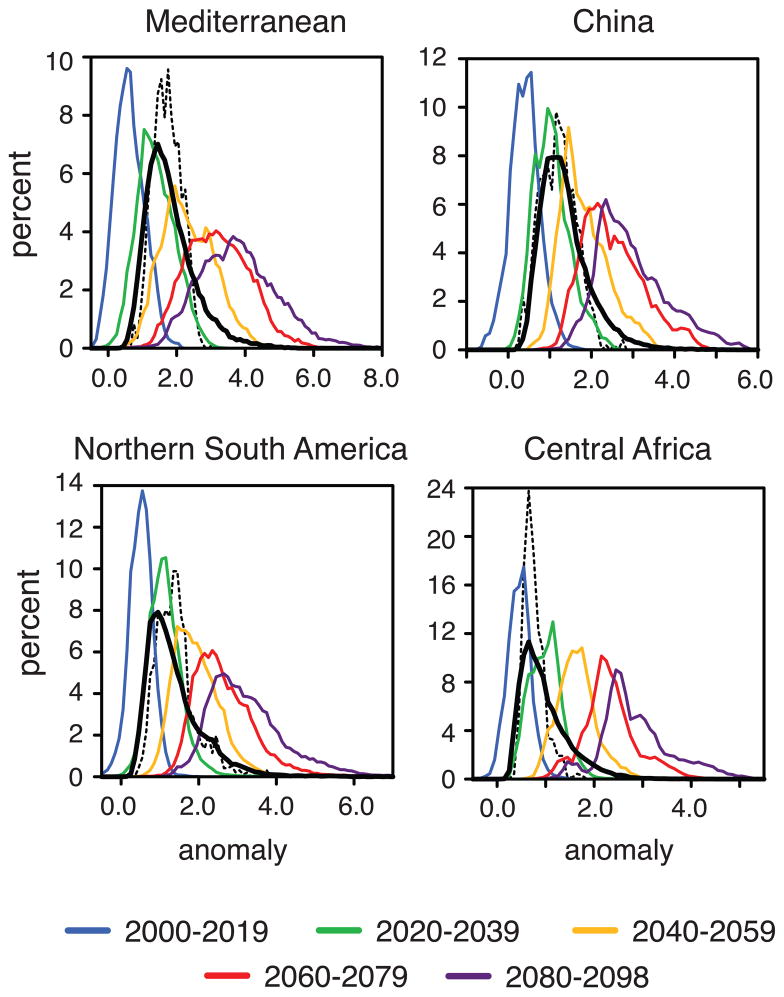Abstract
Given the severe impacts of extreme heat on natural and human systems, we attempt to quantify the likelihood that rising greenhouse gas concentrations will result in a new, permanent heat regime in which the coolest warm-season of the 21st century is hotter than the hottest warm-season of the late 20th century. Our analyses of global climate model experiments and observational data reveal that many areas of the globe are likely to permanently move into such a climate space over the next four decades, should greenhouse gas concentrations continue to increase. In contrast to the common perception that high-latitude areas face the most accelerated response to global warming, our results demonstrate that in fact tropical areas exhibit the most immediate and robust emergence of unprecedented heat, with many tropical areas exhibiting a 50% likelihood of permanently moving into a novel seasonal heat regime in the next two decades. We also find that global climate models are able to capture the observed intensification of seasonal hot conditions, increasing confidence in the projection of imminent, permanent emergence of unprecedented heat.
Keywords: global warming, climate change impacts, extreme heat, CMIP3, signal-to-noise
2. Introduction
Extreme heat exerts severe impacts on natural and human systems. These impacts are particularly acute in the areas of human health [1, 2], agricultural production [3, 4], and food security [5], and in the most severe cases may also substantially reduce ecosystem productivity [6].
Given the severity of these impacts, considerable attention has been given to understanding how hot extremes are likely to respond to elevated greenhouse forcing. This attention has generated ample evidence that continued increases in global greenhouse gas (GHG) concentrations are likely to result in increases in the occurrence and intensity of extreme hot events [7], and that this intensification could substantially increase stress on heat-sensitive systems (e.g., [2, 3, 5]). Indeed, the response of extreme temperature to enhanced radiative forcing is sufficiently strong to suggest that the “2 °C” mitigation target agreed upon by the international community [9] is not likely to avoid intensification of severe hot events [10, 11], and that unconstrained increases in GHG concentrations could cause large areas of the globe to become too hot to be habitable [8].
However, despite the considerable insight that has been gained into the response of hot extremes to elevated radiative forcing, a key issue that has not yet been explored is the timing of emergence of a novel heat regime in which the new minimum is hotter than the baseline maximum. In addition to increasing the occurrence of severe hot events, a permanent transition to an unprecedented heat regime could substantially increase climate-related stresses by requiring systems to tolerate a novel temperature envelope in which the new conditions are hotter than the hottest conditions to which those systems are currently accustomed. The likelihood that such a novel heat regime could emerge in different parts of the globe as greenhouse gas concentrations continue to increase in the coming decades has not yet been constrained.
We therefore seek to quantify the time of emergence of seasonal temperatures that permanently exceed the hottest season of the late 20th century. This quantification is of both scientific and public interest. Climate policy decisions are currently focused in two primary domains: (1) “mitigation”, – or avoidance – of increases in GHG concentrations, and (2) “adaptation” to climatic changes that do occur or are expected to occur. Given that extreme heat already causes a broad array of severe impacts on natural and human systems, quantifying how quickly a novel heat regime could emerge in different areas of the globe is important both for determining the “safe” target for mitigation policy and for generating successful climate change adaptation plans, particularly if the emergence is more abrupt than the horizon for effective action in either the mitigation or adaptation domain [12].
3. Methods
We analyze simulated surface air temperature from the CMIP3 global climate model archive [13]. We analyze a total of 52 realizations of the 24 models that contributed both 20th century and A1B [14] simulations. We focus on 3 metrics of severe heat emergence, calculated separately for June-July-August (JJA) and December-January-February (DJF) surface air temperature: (1) the percentage of seasons warmer than the late 20th century maximum; (2) the “time of emergence” of ensemble exceedence of the late 20th century maximum; and (3) the timing of the last occurrence of a season cooler than the late 20th century maximum. These are probabilistic metrics, and we calculate them across the realizations in the CMIP3 ensemble. Following [15] and [16], we first interpolate each of the CMIP3 realizations to a common 1- degree grid.
For (1), we first calculate the difference between the seasonal temperature and the hottest season of the late 20th century baseline period, at each grid point for each year of each realization. Then, for each 21st century period, we calculate the total number of seasons in the ensemble that are hotter than the respective late 20th century maximum, and divide by the total number of years in the ensemble during that period.
For (2), we follow [16] to quantify the date at which the ensemble mean warming above the late 20th century maximum emerges above the ensemble spread (see schematic Fig. S1 illustrating one grid point). First, for each 21st century realization at each grid point, we calculate the difference between the decadal-mean seasonal temperature and the maximum seasonal temperature of the late 20th century baseline period, for all possible 21st century decadal averages (i.e. 2000–2009, 2001–2010, …, 2089–2098). We then identify the last decade in which the ensemble-mean difference-from-maximum is less than the standard deviation of the difference-from-maximum of the individual realizations.
For (3), we apply the time of emergence framework to quantify the date at which the seasonal temperature in each realization permanently exceeds the late 20th century maximum (see Fig. S1). We first calculate the difference between the seasonal temperature and the hottest season of the late 20th century baseline period, at each grid point for each year of each realization. We then identify the last year in which the seasonal mean is less than the late 20th century maximum at each grid point in each realization, and calculate the earliest, 25th percentile, median, 75th percentile, and latest values across all realizations. For (2) and (3), we cannot confirm whether the exceedence is permanent beyond the 21st century, and therefore consider all last exceedences beyond 2080 to be not permanent.
We compare the CMIP3 ensemble simulation of the historical period with the observational dataset of Willmott and Matsuura [17] (version 4.01 [18]). We use 1980–1999 as a late 20th century baseline and 1952–1969 as a mid 20th century baseline. (We have also used 1951–1999 as a baseline and find the results to be very similar to those with the 1980–1999 baseline.)
4. Results and Discussion
4.1. The Global Pattern of Permanent Emergence
We find that the most immediate increase in extreme seasonal heat occurs in the tropics, with up to 70% of seasons in the early 21st century period (2010–2039) exceeding the late 20th century maximum (for both JJA and DJF) (Fig. 1). This tropical intensification continues with higher GHG concentrations, including greater than 90% of seasons exceeding the baseline maximum over most of tropical Africa, tropical South America, and Southeast Asia in the late 21st century (2070–2098). In the extra-tropics, exceedence is generally greater during the summer than the winter, including greater than 90% over much of extra-tropical Africa, southern Eurasia, and western North America in the late 21st century. The ensemble signal of extreme seasonal heat occurrence emerges above one standard deviation of the ensemble spread in the decade of the 2030s over the tropical oceans in JJA and DJF, in the decade of the 2040s over areas of tropical Africa and western South America in JJA and DJF, and in the decade of the 2040s over areas of northern Africa and southern Eurasia in JJA (Fig. 2).
Figure 1.
The percentage of seasons in the CMIP3 A1B ensemble for which the surface air temperature exceeds the warmest season of the 1980–1999 period. The early 20th century period is 2010–2039, the mid 20th century period is 2040–2069, and the late 20th century period is 2070–2098.
Figure 2.
Decade of emergence of extreme surface air temperature. The top row shows the time of emergence (TOE) of the ensemble signal, calculated as the decade in which the ensemble mean seasonal temperature difference from the 1980–1999 maximum becomes permanently greater than the spread (one standard deviation) between the individual member differences from the 1980–1999 maximum. The second row shows the decade of the last occurrence of a season that is cooler than the 1980–1999 maximum, calculated as the median of the values across the CMIP3 ensemble. We cannot confirm whether the exceedence is permanent beyond the end of the 21st century, and therefore eliminate dates after 2080. Further details of both metrics are given in the text, and in Fig. S1.
In addition to the time of emergence of a robust signal across the ensemble, we also identify the last season in each model realization that is cooler than that realization’s late 20th century maximum. This last occurrence signifies the date of permanent 21st century exceedence of the baseline maximum in each realization, and the ensemble distribution of dates can be quantified at each grid point from the dates in the individual realizations. The earliest date of permanent exceedence across the ensemble occurs during the first decade of the 21st century over much of the tropics in both seasons, as well as areas of North America, northern Africa, and Eurasia in JJA (Fig. S2). The median date of permanent exceedence occurs by the end of the 2020s over the tropical oceans and parts of tropical Africa, and by the end of the 2050s over most of the tropics and large areas of northern Africa and southern Eurasia (Fig. 2). The 25th percentile permanent exceedence emerges prior to 2060 over large areas of extra-tropical North America, South America, Africa and Eurasia, while the 75th percentile is confined primarily to the tropics prior to 2060.
4.2. Regional Emergence
Of the tropical land areas, the regions of Central Africa and Southeast Asia show the most rapid and robust intensification of extreme seasonal heat, with at least 60% of regional land area exceeding the late 20th century maximum after the mid-2040s in the ensemble mean, and after the mid-2080s in all realizations (for JJA; Fig. 3, S3). The ensemble-mean exceedence increases to greater than 90% after 2080 over Central Africa, Southern Africa, Southeast Asia and Northern South America in JJA and DJF. The mean JJA exceedence in the extra-tropical regions of North America, China and the Mediterranean is greater than 60% after 2040 and greater than 80% after 2080. However, all three regions exhibit less immediate intensification of extreme seasonal temperature in DJF (with mean exceedence of less than 40% by 2040 in all three regions), along with much greater variation in intensification across the CMIP3 ensemble (Fig. S4). In contrast, the northern-hemisphere region of India shows more rapid and robust intensification of extreme seasonal heat occurrence in DJF than in JJA (Fig. 1, S2), although both seasons exhibit substantial variation across the CMIP3 ensemble (Fig. S3, S4). The CMIP3 ensemble exhibits greater 21st-century warming over the region in DJF than in JJA [19] (Fig. S5, S6), along with greater agreement in the sign of precipitation change [19]. In addition, the coupling of the regional temperature and precipitation responses through surface-atmosphere interactions [20] suggests that the lack of model agreement in the JJA precipitation response [19, 20] contributes to the lack of agreement in the JJA surface temperature response, which in turn reduces ensemble emergence in JJA (Fig. 2).
Figure 3.
Time series of exceedence of historical temperature extreme. Top row: Time series of the fraction of land grid points with JJA surface air temperatures above the respective 1980–1999 maximum. Bottom row: Time series of the fraction of land grid points with JJA surface air temperatures above the respective 1952–1969 maximum. The grey points denote this fraction for each CMIP3 model realization. The black curves show the mean across all realizations. The red curves show the 10-year running mean of the mean across all realizations. The blue curves show the 10-year running mean of a one-standard-deviation range across the mean of all realizations. The light purple shows the observational timeseries. The dark purple curves show the 10-year running mean of the observational timeseries. The regions cover land areas in Northern South America (25°S-3°N, 82-33°W), Central Africa (1°S–13°N, 18°W–51°E), the Mediterranean (28–50°N, 12°W–38°E), and China (21–43°N, 97–123°E). The trend in the observational timeseries (% per year) is shown in the upper left of the bottom panels, with those trends that are statistically significant identified with a *. The mean of the trends in the CMIP3 realizations is shown in the upper right of the bottom panels, with the number of realizations that exhibit a statistically significant trend shown in bold.
Unprecedented heat emerges most quickly in the tropics despite the fact that the near-term seasonal warming is of similar or greater magnitude in the extra-tropical regions than in the tropical regions (Fig. 4, S5, S6). This tropical intensification results partly from the fact that the late 20th century interannual variability of seasonal temperature is smaller in the tropical regions, decreasing the difference between the mean and maximum of the late 20th century period. For example, very few areas of Central Africa and Southeast Asia exhibit late 20th century differences of greater than 2°C in JJA, while substantial fractions of North America, China and the Mediterranean exhibit differences of greater than 2°C (Fig. 4, S5). Further, North America, China, Southern Africa and the Mediterranean all show smaller interannual variability in summer than in winter (Fig. 4, S5, S6), helping to explain why the emergence of a new temperature regime is more robust in summer than winter in those extra-tropical regions.
Figure 4.
Probability density function (PDF) of JJA surface air temperature anomalies over land for four regions (Mediterranean, China, Northern South America and Central Africa). Each colored PDF represents anomalies for the CMIP3 ensemble for a 2-decade period of the 21st century (relative to the 1980–1999 period). The black lines show the PDF of the differences between the mean and maximum for the 1980–1999 period, with solid black lines showing the CMIP3 values and dashed lines showing the observed values. Regions are as in Figure 3.
4.3. Observational Evidence
We can use the observed emergence of extreme seasonal heat over the late 20th century and early 21st century to assess the ability of the CMIP3 ensemble to simulate future emergence. Observed temperatures show that the globe and 7 of the 8 regions have experienced statistically significant increases in occurrence of maximum warm-season temperature over the past four decades (relative to a mid 20th century baseline; Fig. S7, S8). The CMIP3 ensemble mean underestimates the observed global emergence for both JJA and DJF, while the ensemble-mean emergence is very similar to that seen in warm-season observations over Central Africa, Southern Africa, Northern South America, India, China and the Mediterranean (Fig. S7, S8). Alternatively, the simulated intensification is too strong over Southeast Asia in JJA and DJF, and over North America in JJA.
The CMIP3 ensemble also captures the primary features of the probability distribution of differences between late 20th century mean and maximum seasonal temperature for both JJA and DJF (Fig. 4, S5, S6). However, biases in the CMIP3 distributions likely influence the simulated future emergence of extreme heat over some regions. For instance, the warm tail of the distribution is wider than observed in JJA over Central Africa, China, and the Mediterranean (Fig. 4). This model bias will serve to artificially decrease the intensification of extreme heat occurrence in response to a given seasonal warming, as greater warming is required to exceed the baseline maximum in the CMIP3 ensemble than in reality. Likewise, over India, much of the CMIP3 probability distribution is greater than the observed maximum (Fig. S5), suggesting that the region could in fact see emergence of extreme heat in response to global warming, despite the lack of robust emergence in the CMIP3 ensemble. Conversely, the CMIP3 ensemble under-represents the frequency of grid points with large difference between mean and maximum baseline seasonal temperature over Southeast Asia (Fig. S5, S6). This model bias will serve to artificially increase the exceedence of the late 20th century maximum for a given seasonal warming, as is suggested by the comparison of the CMIP3 suite with observed emergence of extreme heat over Southeast Asia (Fig S7, S8).
4.4. Ensemble Analysis
We have focused on the A1B scenario because it allows us to maximize the number of models and individual realizations available for analysis [7]. While the A1B scenario represents just one possible 21st century emissions pathway, the other illustrative SRES scenarios exhibit similar GHG concentrations through the mid-21st century [14, 21]. In addition, we have presented the distribution of values across the CMIP3 ensemble, treating each model realization equally. Although we have found that repeating the analyses with just one realization from each model yields very similar results as those presented here, a wide range of alternative treatments of the multi-model ensemble exists [22]. The forthcoming CMIP5 multi-model ensemble will provide enhanced opportunities for quantifying the likelihood of near-term emergence of unprecedented heat, particularly given the availability of near-term “decadal prediction” experiments that assimilate ocean observations [23].
5. Conclusions
Our analyses of observational data and the current generation of global climate models carry a number of important implications. First, imminent, permanent emergence of unprecedented heat in the tropical regions is likely to result in substantial human impact, particularly given previous humanitarian crises associated with severe heat [5], and the synergies between environmental and development challenges [24]. Second, the fact that areas of the United States, Europe and China also show permanent emergence by the mid-21st century highlights the fact that nations with developed and emerging economies are also likely to face unprecedented climate stresses even with the relatively moderate warming expected over the next half-century [21]. The fact that global climate models are able to capture the observed intensification of extreme heat globally and over many regions strengthens confidence in the model projections. However, where model biases do exist, they predominantly serve to decrease occurrence of unprecedented heat. Further, actual GHG emissions over the early 21st century have exceeded those projected in the SRES scenario used here [25], suggesting that our results could provide a conservative projection of the timing of permanent emergence of an unprecedented heat regime.
Supplementary Material
Acknowledgments
We acknowledge the modeling groups, PCMDI, the WCRP’s WGCM, and the U.S. DOE for their roles in making the CMIP3 dataset available. The data were analyzed using computing resources provided by the Center for Computational Earth and Environmental Science (CEES) at Stanford University. Our work was supported by NSF award 0955283, DOE award DE-FG02-08ER64649, NIH award S0183091, and the World Bank TFESSD.
References
- 1.Poumadere M, et al. The 2003 heat wave in France: Dangerous climate change here and now. Risk Analysis. 2005;25(6):1483–1494. doi: 10.1111/j.1539-6924.2005.00694.x. [DOI] [PubMed] [Google Scholar]
- 2.Patz JA, et al. Impact of regional climate change on human health. Nature. 2005;438(7066):310–317. doi: 10.1038/nature04188. [DOI] [PubMed] [Google Scholar]
- 3.White MA, et al. Extreme heat reduces and shifts United States premium wine production in the 21st century. Proceedings of the National Academy of Sciences. 2006;103(30):11217–11222. doi: 10.1073/pnas.0603230103. [DOI] [PMC free article] [PubMed] [Google Scholar]
- 4.Schlenker W, Roberts MJ. Nonlinear temperature effects indicate severe damages to US crop yields under climate change. Proceedings of the National Academy of Sciences of the United States of America. 2009;106(37):15594–15598. doi: 10.1073/pnas.0906865106. [DOI] [PMC free article] [PubMed] [Google Scholar]
- 5.Battisti DS, Naylor RL. Historical Warnings of Future Food Insecurity with Unprecedented Seasonal Heat. Science. 2009;323(5911):240–244. doi: 10.1126/science.1164363. [DOI] [PubMed] [Google Scholar]
- 6.Ciais P, et al. Europe-wide reduction in primary productivity caused by the heat and drought in 2003. Nature. 2005;437(7058):529–533. doi: 10.1038/nature03972. [DOI] [PubMed] [Google Scholar]
- 7.Solomon S, et al., editors. IPCC, WGI. Climate Change 2007: The Physical Science Basis: Contribution of Working Group I to the Fourth Assessment Report of the Intergovernmental Panel on Climate Change. Cambridge, UK: Cambridge University Press; 2007. [Google Scholar]
- 8.Sherwood SC, Huber M. An adaptability limit to climate change due to heat stress. Proceedings of the National Academy of Sciences of the United States of America. 2010;107(21):9552–9555. doi: 10.1073/pnas.0913352107. [DOI] [PMC free article] [PubMed] [Google Scholar]
- 9.UNFCCC. The Copenhagen Accord. Fifteenth session; Copenhagen. 7–18 December 2009; The United Nations; 2009. p. 5. [Google Scholar]
- 10.Clark RT, Murphy JM, Brown SJ. Do global warming targets limit heatwave risk? Geophysical Research Letters. 2010;37 doi: 10.1029/2010GL043898. [DOI] [Google Scholar]
- 11.Diffenbaugh NS, Ashfaq M. Intensification of hot extremes in the United States. Geophysical Research Letters. 2010;37:L15701. doi: 10.1029/2010GL043888. [DOI] [Google Scholar]
- 12.Carter TR, et al. New assessment methods and the Characterisation of future conditions. In: Parry ML, et al., editors. Climate Change 2007: Impacts, Adaptation and Vulnerability. Contribution of Working Group II to the Fourth Assessment Report of the Intergovernmental Panel on Climate Change. Cambridge University Press; Cambridge, UK: 2007. pp. 133–171. [Google Scholar]
- 13.Meehl GA, et al. The WCRP CMIP3 multimodel dataset - A new era in climate change research. Bulletin of the American Meteorological Society. 2007;88(9):1383. [Google Scholar]
- 14.IPCC, WGI. Special Report on Emissions Scenarios. In: Nakicenovic N, Swart R, editors. Intergovernmental Panel on Climate Change Special Reports on Climate Change. Cambridge, UK: Cambridge University Press; 2000. p. 570. [Google Scholar]
- 15.Giorgi F, X Bi. Updated regional precipitation and temperature changes for the 21st century from ensembles of recent AOGCM simulations. Geophysical Research Letters. 2005;32:L21715. doi: 10.1029/2005GL024288. [DOI] [Google Scholar]
- 16.Giorgi F, Bi X. Time of emergence (TOE) of GHG-forced precipitation change hot-spots. Geophysical Research Letters. 2009;36:L06709. doi: 10.1029/2009GL037593. [DOI] [Google Scholar]
- 17.Willmott CJ, Matsuura K. Terrestrial air temperature and precipitation: monthly and annual time series (1950–1999) University of Delaware; 2001. http://climate.geog.udel.edu/~climate/html_pages/air_ts2.html. [Google Scholar]
- 18.Matsuura K, Willmott CJ. Terrestrial air temperature: 1900–2008 gridded monthly time series (version 2.01) 2009 http://climate.geog.udel.edu/~climate/html_pages/Global2_Ts_2009/README.global_t_ts_2009.html.
- 19.Christensen JH, et al. Regional Climate Projections. In: Solomon S, et al., editors. Climate Change 2007: The Physical Science Basis. Contribution of Working Group I to the Fourth Assessment Report of the Intergovernmental Panel on Climate Change. Cambridge University Press; Cambridge, United Kingdom and New York, NY, USA: 2007. [Google Scholar]
- 20.Ashfaq M, et al. Suppression of south Asian summer monsoon precipitation in the 21st century. Geophysical Research Letters. 2009;36:L01704. doi: 10.1029/2008GL036500. [DOI] [Google Scholar]
- 21.Meehl GA, et al. Global climate projections. In: Solomon S, et al., editors. Climate Change 2007: The Physical Science Basis. Contribution of Working Group I to the Fourth Assessment Report of the Intergovernmental Panel on Climate Change. Cambridge University Press; Cambridge, United Kingdom and New York, NY, USA: 2007. [Google Scholar]
- 22.Knutti R, et al. Challenges in Combining Projections from Multiple Climate Models. Journal of Climate. 2010;23(10):2739–2758. [Google Scholar]
- 23.Taylor KE, Stouffer RJ, Meehl GA. A summary of the CMIP5 experimental design, 18 December, 2009. PCMDI, Lawrence Livermore National Laboratory; Livermore, CA: 2009. p. 32. [Google Scholar]
- 24.UNDP. Human Development Report 2007/2008: Fighting Climate Change: Human Solidarity in a Divided World. New York, NY: Palgrave Macmillan for the United Nations Development Programme; 2007. p. 384. [Google Scholar]
- 25.Raupach MR, et al. Global and regional drivers of accelerating CO2 emissions. Proceedings of the National Academy of Sciences. 2007;104(24):10288–10293. doi: 10.1073/pnas.0700609104. [DOI] [PMC free article] [PubMed] [Google Scholar]
Associated Data
This section collects any data citations, data availability statements, or supplementary materials included in this article.






